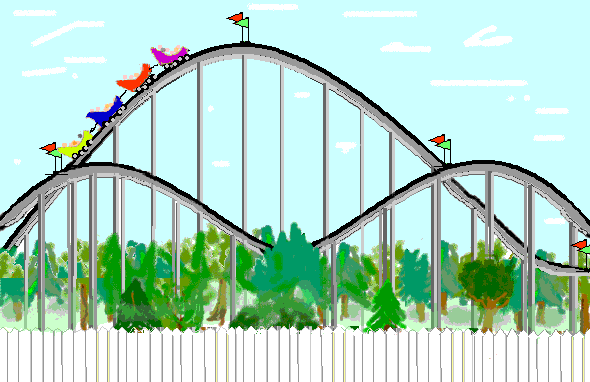My favorite roller coaster is “The Hulk” located in Disney
World at Islands of Adventure.
“The Hulk” is a modern day roller coaster that uses high amounts of
acceleration and components that provide hydraulic or pneumatic power. It is a launched roller coaster, which
gives a lot of speed. “The Hulk” would be best on planet Jupiter because it will
travel quickly because it has more gravitational pull and this will help the roller coasters’ velocity
and speed. Jupiter is a much larger planet and has more mass than other planets so the roller coaster could be larger making room for more design of loops and hills within the roller coaster. Unlike Mercury with all of its mountain ranges, the ground on Jupiter is smooth and would allow for more placement options. With Mercury being the smallest and furthest from the sun, this would make the environment not the best to enjoy a roller coaster at high speeds. Mercury also has several meteor
contacts and large impact craters, this would make it unsafe for riders on Mercury. So for my
favorite roller coaster “The Hulk”, Jupiter would be a better planet to have a roller coaster over Mercury. Ultimately Earth would be ideal with the equal parts of gravity and energy that it has.
Thursday, January 2, 2014
Question #2: Conservation of Energy
 |
| Diagram of Roller Coaster Ride |
Step 2: Potential Energy transforms into Kinetic Energy as gravity pulls the
cart down the hill. During the transformation the Potential and Kinetic Energy
are at their minimum and maximum.
Step 3: Hills following the first hill are usually smaller
because Potential Energy decreases and transforms into Kinetic Energy the longer
the roller coaster ride. Usually there is more Kinetic Energy than Potential
Energy at this step. Friction also plays a part in the stopping process at the
end of the roller coaster.
Question #3: Trapped between 2 Hills
Energy is transformed as the mechanics or environment of an object changes. If traveling down a roller coaster hill and the cart gets stuck before reaching the top of the next hill, then the designer forgot about the transfromation of energy as well as the effects gravity has on the cart. Potential Energy is lost when the cart goes down the first hill and the Kinetic Energy becomes higher. The second hill needs to be smaller than the first to support the equal amounts of Kinetic and Potential Energy created when the cart reaches the bottom of the first hill. If the second hill is larger than the first, gravity will interfere with the transformation of energy, causing the cart to stay where it is versus having enough energy to launch into the next level of the roller coaster.
Question #4: Upside - Down Loop
Loops on roller coasters are not actually loops, they usually take the
shape of a tear drop to help with the "g" forces and to not make the ride
to harsh for the users. The acceleration force is most high at the beginning
of the roller coaster ride. Therefore, placing a loop at the beginning or after
points of high Kinetic Energy would allow the cart to fully cycle through the
loop versus rolling back down with the pull of gravity. The slowest point
of the loop is the very top and this helps with the closing of the loop when
riding back down also.
Question #6: The Thrill
When you ride a roller coaster, it would have psychological effects on you even if you weren’t terrified of them already, some researcher’s claim that roller coasters also put a great amount of physiological strain on your body and can even cause death. The thrill of a roller coaster ride with its climbs, loops and dives can increase the heart rate, setting off a dysfunctional heartbeat that could cause heart attacks in people with heart disease. The sociological effects occur when someone may not want to ride a roller coaster and they are effected by observing the behaviors of others while they are on a roller coaster. Most people who ride roller coasters may yell and scream, this could be very intimidating for someone who is unsure of the experience. If you are a person that enjoys roller coasters, this observation would excite you, but again if you are skeptical this type of reaction could put more fear and strain in the thoughts of getting on the roller coaster yourself.
Question #8: Thrill Factor
The roller
coaster does not move at first until hauled to the top of an incline. The
roller coaster then accelerates and remains in motion for several rises and
falls, slows down and then accelerates again by gravity, but loses energy to
friction. As you're slowly going up the roller coaster, you start to feel heavier,
once you come to the top gravity begins to take you down. When you're going
down, there's more acceleration and you start to feel lighter because there are
more "g" forces being put on you. This can be proven by the rider
physically being lifted out of their seat when going downhill on a roller
coaster.
Subscribe to:
Posts (Atom)





